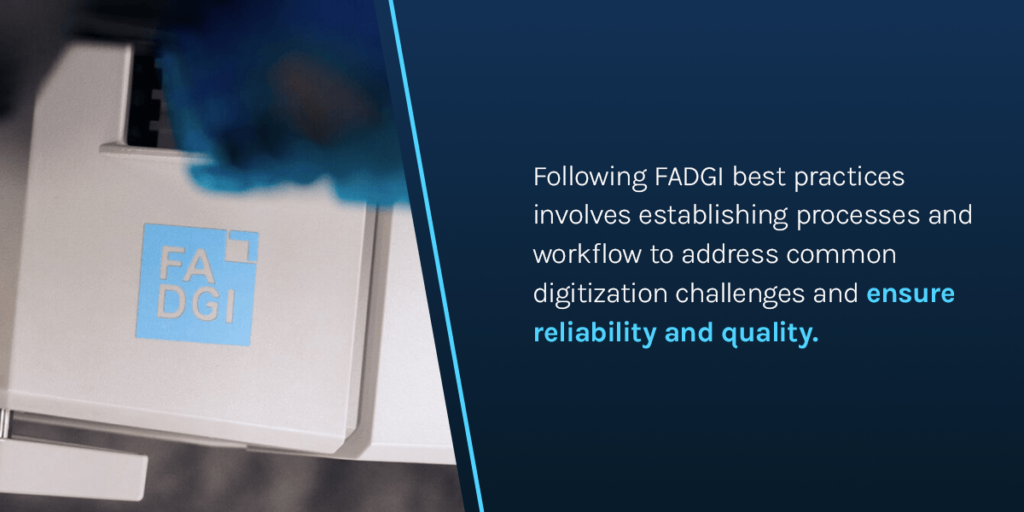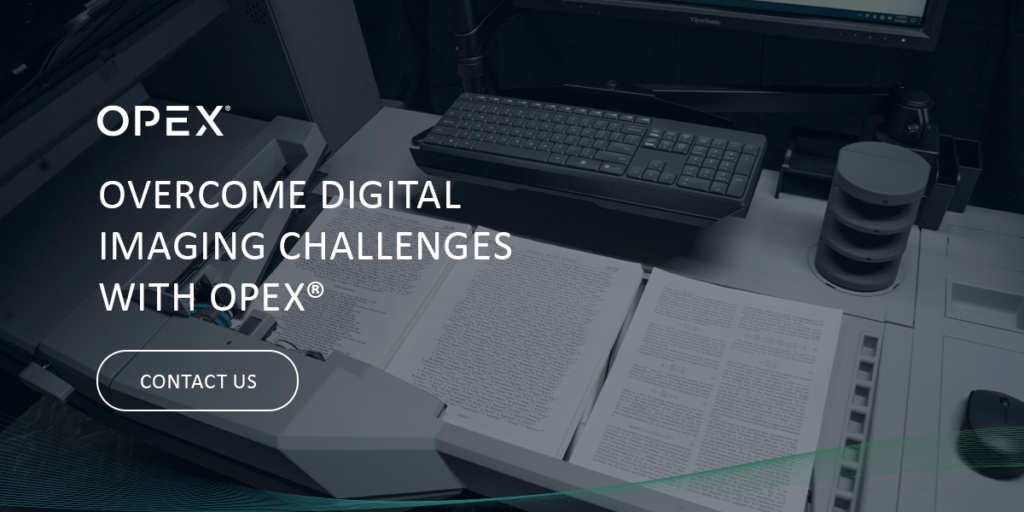60-Second Summary
FADGI, or the Federal Agencies Digital Guidelines Initiative, sets the national standard for high-quality digital imaging of archival materials. Designed to preserve the integrity of born-digital and digitized content—such as images, audio, and video—FADGI offers a structured framework that includes technical guidelines, best practices, conformance evaluations, and staff training. Its widely recognized star-rating system (from one to four stars) evaluates compliance based on factors like resolution, quality control, and preservation standards. Although only mandatory for federal agencies, many private organizations pursue FADGI compliance to ensure consistent, reliable, and accessible digital outputs. Achieving compliance requires clear processes, modern equipment, regular testing, and ongoing staff education to maintain long-term preservation excellence.
Businesses and organizations worldwide can enhance efficiency and drive growth by leveraging digitized content through paperless billing, streamlined communication, and quick document uploading. Ensuring the proper preservation of files during digitization is essential for effective record management and review.
The Federal Agencies Digital Guidelines Initiative (FADGI) provides standards and guidelines that promote high-quality digital reproductions. These stringent quality standards ensure digitized records are preserved accurately and reliably.
The Importance of Digital Imaging Standards
FADGI depicts sustainable guidelines and practices for born-digital or digitized archives and records. These recommendations and methods aim to standardize the quality of digital content, including video files, audio, and images.
Adhering to these guidelines helps organizations maintain material integrity and empower long-term content access. Additionally, creating uniform digitizing standards helps federal agencies produce reliable digital copies of original materials.
What Is FADGI Compliance?
Organizations that manage federal projects must meet FADGI standards. Although private sectors don’t need to meet FADGI compliance, it’s becoming more common for these organizations to seek FADGI compliance to ensure their outputs meet industry standards.
Becoming FADGI compliant involves four main components:
- Technical guidelines: Teams must adhere to the FADGI guidelines for their specific document types. Depending on the specific documents, teams can implement a variety of scanning technologies, software, and processes to ensure technical guideline adherence.
- Best practices: Following FADGI best practices involves establishing processes and workflows to address common digitization challenges and ensure reliability and quality. You need FADGI-capable equipment, such as scanners capable of meeting the imaging standards and software to identify the color charts/dice charts and output the correct file types.
- Digital Imaging Conformance Evaluation: Organizations must implement consistent and repeatable processes for digital content. Ongoing testing and validation processes are necessary for monitoring success if changes occur.
- Staff training and certification: Experienced staff must be knowledgeable about the entire digitization process, from operating equipment to preparing materials to ensuring final outputs adhere to FADGI standards.

FADGI Requirements Overview
FADGI emphasizes image quality and uses a rating system to determine the level of compliance needed for certain records.
FADGI also outlines guidelines for heritage and culture media and modern textual records (MTR). Most FADGI submissions refer to MTR guidelines because MTR compliance covers a wide range of documents. These guidelines are used for books and journals, laser-printed documents, photographic prints, and other office paper documents with a high contrast between paper background and text.
Alternatively, antique records and other heritage documents rely on a star rating system to determine compliance. Higher stars correlate to more precise copies and showcase a team’s ability to preserve original copies in digital formats.
- One star: One-star compliance indicates minimal adherence to FADGI guidelines. This rating depicts an organization’s ability to meet basic standards with processes or equipment that lack accuracy or quality. This rating isn’t sufficient for high-quality reproduction projects but may be adequate for basic digitization tasks.
- Two stars: A two-star rating depicts moderate compliance. Processes and equipment with this rating have satisfactory performance and adhere to most FADGI recommendations. Two-star ratings are generally suitable for many digitization projects.
- Three stars: As of June 2024, federal agencies only accept digital materials with a three-star FADGI rating or higher. Three stars indicate excellent compliance, and equipment and processes with this rating demonstrate superior performance in preservation standards. This rating is suitable for demanding reproduction projects needing high-quality outputs.
- Four stars: The highest FADGI rating is four stars. This rating highlights the ability of equipment and processes to meet or exceed all FADGI recommendations and produce outstanding digital outputs. A four-star rating is critical for extremely demanding applications.
Criteria impacted by star ratings include:
- Image resolution: FADGI guidelines depict image resolution requirements in pixels per inch or dots per inch. Higher resolutions are more suitable for capturing minute details and ensuring material fidelity.
- Quality control: Quality control is crucial throughout the digitization process. Factors that impact quality control may include image monitoring quality, equipment calibration procedures, inspection processes, and consistency across multiple outputs.
- Preservation standards: FADGI guidelines aim to preserve historic content, making preservation standards integral to FADGI compliance. Storage best practices, archival principles, and file format sustainability can impact this metric.
- Dynamic range: The ability of processes and equipment to represent and capture all shades and tones in original materials is known as dynamic range. A satisfactory dynamic range will encompass shadows and highlights.
- File formats: Open and standardized file formats are best for ensuring long-term digital accessibility. Suitable options often include JPEG and TIFF formats.
- Metadata standards: Metadata schemas and standardized vocabularies impact content management and retrieval. Using best practices facilitates material discovery.
How to Ensure FADGI Digitization Standards Compliance
Implementing compliance best practices can help you align your organization’s initiatives and processes with FADGI recommendations and requirements. Consider these best practices:
- Understand requirements: Each industry and sector can have unique requirements for achieving FADGI compliance and industry standards. Understand the star rating your organization needs to determine the best practices for reaching success. Build your compliance processes around reaching that star rating.
- Implement training: Operator training is crucial for ensuring each team member can operate equipment and understand system capabilities when producing outputs. Invest in ongoing training to ensure team members are updated on best practices.
- Upgrade equipment: Consider whether your team needs to upgrade its equipment to better meet standards. Outdated equipment with accuracy or performance issues can make it more difficult to align with FADGI guidelines. Investing in modern solutions can be the difference in reaching and maintaining compliance.
- Test and evaluate: Organizations must have repeatable processes, and you should continuously test processes and equipment to identify inconsistencies or deficiencies. Address problems promptly and continue testing until you obtain consistent and accurate results.
Overcome Digital Imaging Challenges With OPEX®
Storing and managing digital content is crucial in today’s ever-evolving digital world. You need reliable solutions that save time, ensure consistency, and optimize workflows.
OPEX offers comprehensive solutions to address these challenges and more. OPEX’s FADGI-capable document imaging solution aids in converting physical materials into digital copies to help reduce manual processes and improve efficiency. This solution empowers businesses to meet stringent guidelines and ensure long-lasting material accessibility.
Our FADGI-capable solutions feature powerful imaging software to ease transitions while boosting productivity and delivering measurable cost savings. Explore OPEX’s solutions today or connect with us to learn more about our capabilities.
Other Resources You Might Find Helpful
OPEX® Falcon+® RED One-touch Scanning
Legastat: When Flatbed Scanning is NOT Enough
Falcon+® Scanner Series
Built for Compliance: How Modern Scanning Systems Deliver Operational Excellence
Record Partners Provides High-Volume Critical Record Digitization with New Technology
EXL: Critical Efficiency Improvements in Document Management
The Imagine Group: Accelerating the Data Entry Process for Returned Mail with a Solution from OPEX® and CPT
Georgia Department of Revenue Accelerates Processing Times by Automating the Open, Prep, and Scan Process
An Post Commerce Business Solutions Implements OPEX® Scanning Technology, Achieving a 33% Increase in
Paragon Boosts Efficiency with OPEX®’s One-Touch Scanning and Mail Opening Solution
NEXT LEVEL AUTOMATION
Unlock Operational Efficiency with OPEX
OPEX is powering the future of automation. Contact us to learn more about how our vertically integrated automated solutions can help take your business to new heights.
